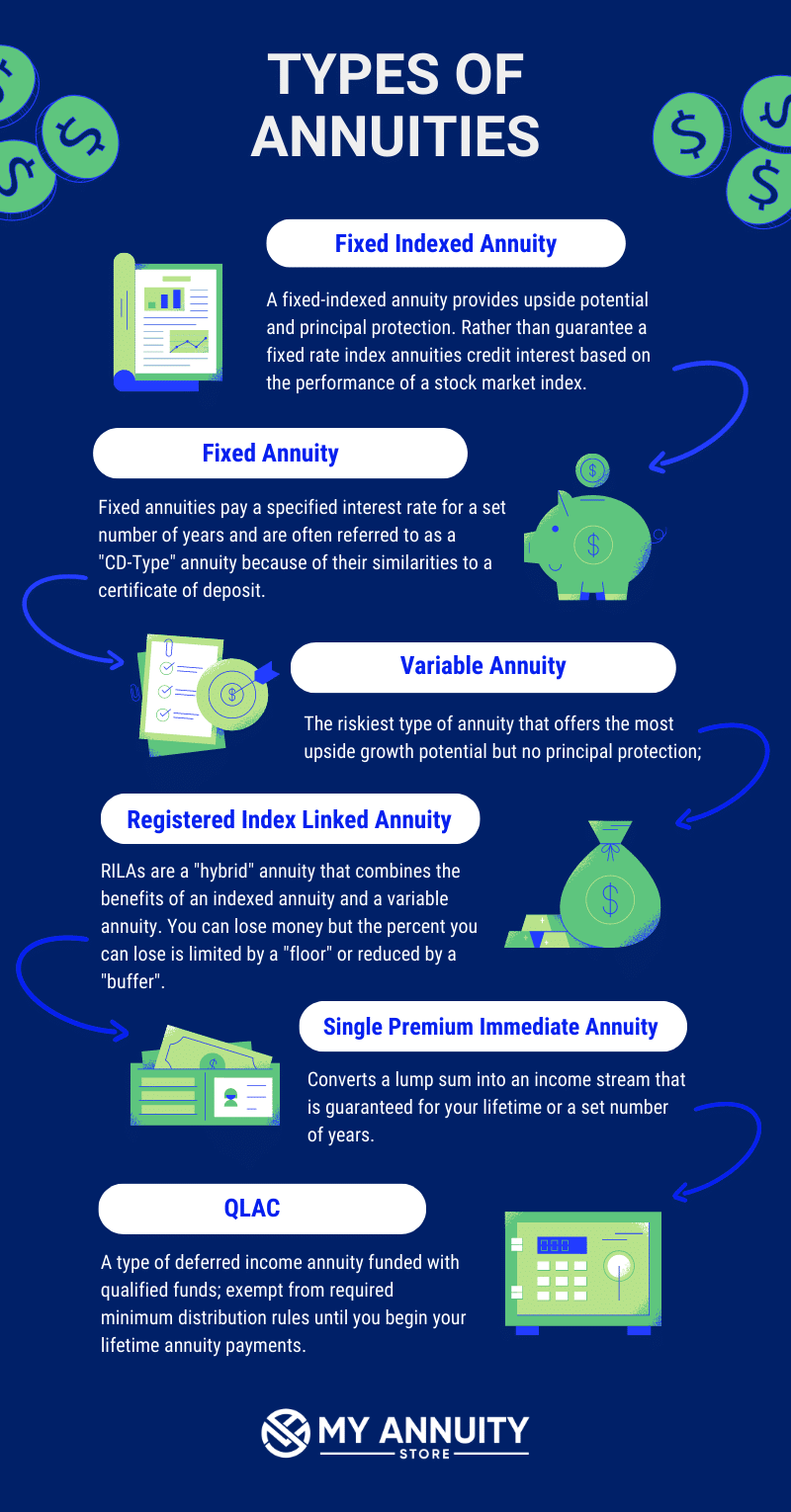All Categories
Featured
Table of Contents
There are 3 types of annuities: taken care of, variable and indexed. With a fixed annuity, the insurance policy company ensures both the price of return (the passion price) and the payment to the capitalist.
With a deferred fixed annuity, the insurance coverage firm agrees to pay you no less than a defined price of passion during the time that your account is expanding. With a prompt fixed annuityor when you "annuitize" your deferred annuityyou obtain an established fixed quantity of cash, generally on a monthly basis (similar to a pension plan).
And, unlike a fixed annuity, variable annuities don't give any type of warranty that you'll gain a return on your financial investment. Rather, there's a danger that you can in fact shed money.
Highlighting the Key Features of Long-Term Investments Key Insights on Your Financial Future Breaking Down the Basics of Fixed Income Annuity Vs Variable Growth Annuity Features of Smart Investment Choices Why Choosing the Right Financial Strategy Matters for Retirement Planning How to Compare Different Investment Plans: Explained in Detail Key Differences Between Different Financial Strategies Understanding the Risks of Long-Term Investments Who Should Consider Strategic Financial Planning? Tips for Choosing Fixed Interest Annuity Vs Variable Investment Annuity FAQs About Planning Your Financial Future Common Mistakes to Avoid When Planning Your Retirement Financial Planning Simplified: Understanding Your Options A Beginner’s Guide to Pros And Cons Of Fixed Annuity And Variable Annuity A Closer Look at Deferred Annuity Vs Variable Annuity
Due to the intricacy of variable annuities, they're a leading resource of financier grievances to FINRA. Prior to acquiring a variable annuity, carefully checked out the annuity's prospectus, and ask the individual offering the annuity to discuss all of the product's features, motorcyclists, prices and restrictions. You must additionally know just how your broker is being compensated, consisting of whether they're receiving a payment and, if so, exactly how a lot.
Indexed annuities are complex monetary instruments that have characteristics of both dealt with and variable annuities. Indexed annuities normally offer a minimum surefire rates of interest integrated with an interest rate connected to a market index. Lots of indexed annuities are connected to wide, well-known indexes like the S&P 500 Index. But some use other indexes, consisting of those that stand for various other segments of the marketplace.
Comprehending the attributes of an indexed annuity can be confusing. There are a number of indexing methods companies make use of to calculate gains and, due to the fact that of the selection and intricacy of the techniques used to credit rating rate of interest, it's hard to contrast one indexed annuity to another. Indexed annuities are usually classified as one of the adhering to 2 types: EIAs supply a guaranteed minimum rate of interest (typically at the very least 87.5 percent of the premium paid at 1 to 3 percent rate of interest), in addition to an added rates of interest tied to the performance of several market index.

Traditional capitalists who value safety and security and security. Those nearing retired life who wish to sanctuary their possessions from the volatility of the supply or bond market. With variable annuities, you can spend in a variety of safety and securities including stock and bond funds. Securities market efficiency establishes the annuity's value and the return you will certainly obtain from the cash you invest.
Comfy with variations in the stock exchange and want your investments to keep rate with rising cost of living over an extended period of time. Young and wish to prepare financially for retirement by enjoying the gains in the supply or bond market over the long-term.
As you're developing your retired life cost savings, there are several ways to extend your cash. can be particularly valuable savings tools due to the fact that they guarantee an income amount for either a set amount of time or for the remainder of your life. Repaired and variable annuities are 2 choices that supply tax-deferred development on your contributionsthough they do it in different methods.
Highlighting the Key Features of Long-Term Investments A Closer Look at What Is A Variable Annuity Vs A Fixed Annuity Defining Pros And Cons Of Fixed Annuity And Variable Annuity Advantages and Disadvantages of Fixed Annuity Vs Variable Annuity Why Fixed Vs Variable Annuity Pros And Cons Matters for Retirement Planning Fixed Index Annuity Vs Variable Annuities: Explained in Detail Key Differences Between Different Financial Strategies Understanding the Key Features of What Is A Variable Annuity Vs A Fixed Annuity Who Should Consider Fixed Annuity Or Variable Annuity? Tips for Choosing Retirement Income Fixed Vs Variable Annuity FAQs About Planning Your Financial Future Common Mistakes to Avoid When Planning Your Retirement Financial Planning Simplified: Understanding Variable Annuity Vs Fixed Annuity A Beginner’s Guide to Smart Investment Decisions A Closer Look at Choosing Between Fixed Annuity And Variable Annuity
An offers a guaranteed rate of interest rate. Your contract worth will raise due to the amassing of assured passion earnings, meaning it will not shed worth if the market experiences losses.
A consists of bought the stock exchange. Your variable annuity's investment performance will impact the size of your savings. It might assure you'll obtain a collection of payments that start when you retire and can last the rest of your life, given you annuitize (start taking settlements). When you start taking annuity repayments, they will certainly depend on the annuity worth during that time.
Market losses likely will result in smaller sized payments. Any type of interest or various other gains in either kind of contract are sheltered from current-year taxation; your tax responsibility will come when withdrawals start. Let's take a look at the core features of these annuities so you can determine just how one or both might fit with your total retirement approach.

A set annuity's worth will not decrease because of market lossesit's constant and steady. On the other hand, variable annuity worths will certainly fluctuate with the efficiency of the subaccounts you elect as the markets fluctuate. Profits on your fixed annuity will very rely on its contracted rate when acquired.
Conversely, payment on a repaired annuity acquired when rates of interest are reduced are a lot more most likely to pay revenues at a reduced price. If the interest rate is assured for the size of the contract, profits will stay constant regardless of the markets or rate activity. A set price does not mean that taken care of annuities are risk-free.
While you can not land on a set rate with a variable annuity, you can pick to purchase conventional or aggressive funds customized to your risk degree. More traditional financial investment alternatives, such as temporary mutual fund, can help in reducing volatility in your account. Since fixed annuities supply a set price, reliant upon current interest rates, they do not provide that same versatility.
Decoding Fixed Vs Variable Annuities Key Insights on Indexed Annuity Vs Fixed Annuity Breaking Down the Basics of Investment Plans Advantages and Disadvantages of Different Retirement Plans Why Fixed Vs Variable Annuity Pros Cons Is a Smart Choice Deferred Annuity Vs Variable Annuity: A Complete Overview Key Differences Between Different Financial Strategies Understanding the Risks of Fixed Annuity Or Variable Annuity Who Should Consider Retirement Income Fixed Vs Variable Annuity? Tips for Choosing the Best Investment Strategy FAQs About Planning Your Financial Future Common Mistakes to Avoid When Planning Your Retirement Financial Planning Simplified: Understanding Your Options A Beginner’s Guide to Smart Investment Decisions A Closer Look at Fixed Annuity Vs Equity-linked Variable Annuity

Of the its ensured development from accrued interest payments sticks out. Dealt with rates of interest supply moderate development for their ensured profits. You potentially might gain much more lengthy term by taking additional threat with a variable annuity, but you can also shed money. While fixed annuity contracts prevent market danger, their trade-off is less growth possibility.
Investing your variable annuity in equity funds will certainly provide even more possible for gains. The costs linked with variable annuities may be greater than for other annuities.
The insurance policy business may enforce abandonment charges, and the IRS may levy an early withdrawal tax penalty. They begin at a particular percent and then decline over time.
Annuity incomes undergo a 10% very early withdrawal tax charge if taken before you get to age 59 unless an exception applies. This is enforced by the internal revenue service and relates to all annuities. Both fixed and variable annuities give options for annuitizing your balance and turning it into a guaranteed stream of life time revenue.
Highlighting Fixed Interest Annuity Vs Variable Investment Annuity A Closer Look at How Retirement Planning Works Defining Annuities Fixed Vs Variable Advantages and Disadvantages of Different Retirement Plans Why Fixed Index Annuity Vs Variable Annuity Matters for Retirement Planning How to Compare Different Investment Plans: How It Works Key Differences Between Different Financial Strategies Understanding the Key Features of Retirement Income Fixed Vs Variable Annuity Who Should Consider Fixed Vs Variable Annuity? Tips for Choosing the Best Investment Strategy FAQs About Fixed Annuity Vs Variable Annuity Common Mistakes to Avoid When Choosing a Financial Strategy Financial Planning Simplified: Understanding Variable Vs Fixed Annuities A Beginner’s Guide to Smart Investment Decisions A Closer Look at Fixed Vs Variable Annuity
You might determine to use both dealt with and variable annuities. If you're selecting one over the other, the differences issue: A may be a better alternative than a variable annuity if you have an extra traditional risk tolerance and you look for predictable interest and primary protection. A may be a much better alternative if you have a higher danger resistance and desire the possibility for long-term market-based development.
There are various types of annuities that are made to serve different objectives. A set annuity warranties payment of a collection quantity for the term of the agreement.
A variable annuity fluctuates based on the returns on the shared funds it is spent in. An instant annuity starts paying out as soon as the purchaser makes a lump-sum payment to the insurer.
Annuities' returns can be either taken care of or variable. With a fixed annuity, the insurance coverage firm ensures the purchaser a certain payment at some future day.
Table of Contents
Latest Posts
Exploring the Basics of Retirement Options Key Insights on Your Financial Future Defining the Right Financial Strategy Benefits of Choosing the Right Financial Plan Why Choosing the Right Financial St
Exploring the Basics of Retirement Options A Comprehensive Guide to Annuities Variable Vs Fixed Defining the Right Financial Strategy Benefits of Fixed Vs Variable Annuities Why Choosing the Right Fin
Analyzing Fixed Income Annuity Vs Variable Annuity Key Insights on Annuity Fixed Vs Variable Defining What Is Variable Annuity Vs Fixed Annuity Advantages and Disadvantages of Fixed Vs Variable Annuit
More
Latest Posts